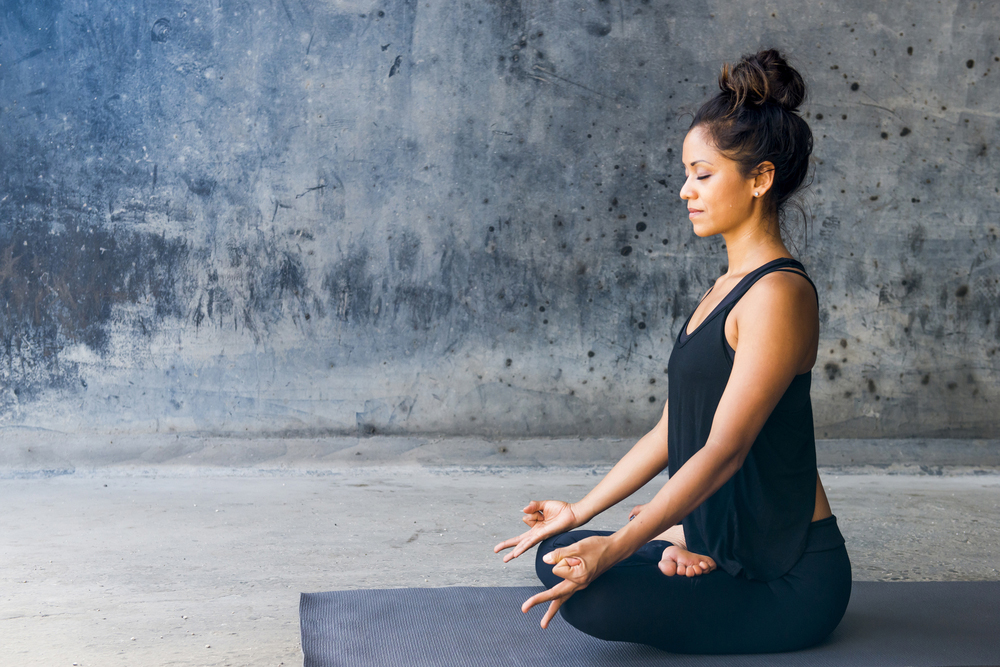Use a simple ancient yoga breathing technique to lower stress and inflammation.
Yoga isn’t just about physical poses. The ancient practice has specific yogic breathing techniques known as pranayama. Yoga breathing has been scientifically shown decrease stress, lower blood pressure, and improve immunity. A new study has found that yoga breathing may also lower stress-related inflammation in the body.
The study published in BMC Complementary and Alternative Medicine found that yoga breathing for just 20 minutes was able to lower stress-related markers of inflammation measured in the saliva.
Researchers examined levels of biomolecules in the body called cytokines in the saliva of twenty participants. Half of the group read text for 20 minutes while the other half did specific yoga breathing exercises: 10 minutes of Om chanting and 10 minutes of rhythmic breathing. Om chanting is an ancient practice that repeats the sound or vibration “Aum.” Rhythmic breathing is a simple breathing exercise that regulates the breath based on specific counts. In this study, yoga instructors taught participants to inhale for two counts, hold for eight counts, and exhale for four counts. The notation for this breathing exercise is 2-8-4, which based on inhalation-hold-exhalation. (Note: There can also be a pause at the end of your breath cycle after exhalation, which is a more advanced technique).
Researchers measured samples from the beginning of the exercise in five-minute intervals up to 20 minutes and found that, at the end of 20 minutes, three stress-related biomarkers significantly decreased in those who did the yoga breathing exercise but not in people who were just reading.
Rhythmic Breathing Exercise
You can experience the relaxing effects of yoga breathing at home, with as little time as one minute a day. Rhythmic yoga breathing can reduce stress and improve focus, and many ratios (not just the 2-8-4 exercise in the study) can be helpful.
Just a short but important note of caution: Yoga should never be painful—this goes for breathing exercises, too.
Rhythmic breathing is a simple yoga breathing technique with set intervals for inhalation, exhalations, with additional pauses after inhalations or exhalations. The breath has four parts: inhalation, pause at the “top” of the breath,” exhalation, and a pause at the “bottom” of the breath. Adding pauses after exhalations is a more advanced technique and should be reserved for those with yoga breathing experience.
Try a simple yoga breathing exercise for as little as a minute a day to reduce stress and relax. It’s best to pick a regular time to practice yoga breathing, whether it’s first thing in the morning, when you transition from work to home, or right before bedtime.
- Come to a comfortable seat and sit upright with your spine tall.
- Close your eyes and bring your attention to your natural breath.
- Inhale through your nostrils for four counts and imagine your lungs filling up from the bottom, middle, and all the way to the top.
- Exhale through your nostril for four counts. Imagine your lungs emptying from top, middle, and the bottom.
- Repeat this breath pattern for 10 cycles.
- Next, inhale your nostrils for four counts, hold for four counts, and then exhale through your nostrils for four counts.
- Repeat this breath pattern for 10 cycles.
Once you are comfortable timing of your breath, you can also repeat sayings or mantras in your mind as your breath to pace yourself.
For example:
I inhale slowly and steadily as I feel my chest expand with air.
I pause to let the air fill and circulate through my entire body.
I exhale to empty all the air from my lungs, releasing any tension.
Try these yoga breathing exercises a few minutes a day, working up to 10-15 minutes over a month. There will be many more yoga breathing exercises in the upcoming book The Harvard Medical School Guide to Yoga.
From: Psychology Today

